Yesterday afternoon I was walking down a street in Rome, wondering, “What was the name of the second church I visited this morning?” A split second later a young man in front of me turned to his two companions and asked, “What was the name of that second bar we went to?” The place was different, but the problem was the same – sensory overload. There are so many things to do in Rome that it is overwhelming. I go from one attraction in Rome to the next, trying to see it all. Before long, it all begins to run together. I decided that to have a better experience of Rome I needed to limit my visits to the popular tourist spots each day and spend the rest of my time discovering the lesser known – or at least less crowded – neighborhoods of Rome.
Rome is built around seven famous hills: the Quirinal, Viminal, Esquiline, Caelian, Aventine, Palatine and Capitoline Hills. In ancient times these seven hills were occupied by small settlements and not recognized as a single city. It was not until the residents of the seven hills began to participate in a series of religious games that the groups began to bond together, eventually draining the marshy valleys between them and turning them into the piazzas that became the City of Rome. Today, Roman life centers around these Piazzas, each similar in that they are a all broad expanses of space that open out from the end of narrow streets and alleyways, but each unique in design. Indeed one could spend a month in Rome, visiting a different piazza each day, and still not see them all.
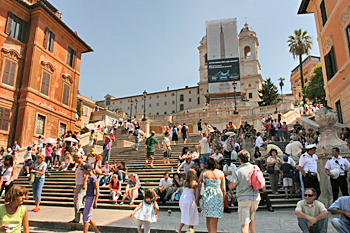
I began with a visit to Piazza di Spagna, with its early Baroque fountain called La Fontana della Barcaccia (Fountain of the Old Boat). From the piazza the famous Spanish Steps climb a steep slope up to the Triniti dei Monti Church. I fought the crowds to get to the upper plaza, then wound my way up into Villa Borghese Park.
From the moment I stepped into the Park the atmosphere changed. Easy listening music drifted from a cafe perched on the lip of the hill at the southern entrance to the park and its sun-dappled courtyard beckoned. I escaped to the shade of an umbrella-covered table and enjoyed a leisurely cup of coffee while I let my sweat-soaked clothes dry in the 95-degree midday heat. Villa Borghese is considered to be Rome’s most important green space. Unique in the world for its concentration of cultural institutions, the park contains five museums, including the Villa Borghese Art Gallery and the National Museum of Modern Art.
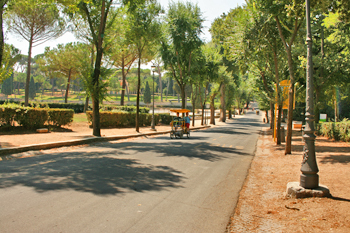
Although I did not venture inside the museums, I spent nearly an hour in the park, investigating its miles of paths, lakes, and picnic areas that are closed to all traffic other than electric carts, bicycles, and pedestrians. It is easily my most favorite spot in Rome thus far.
On the western side of the park I descended to yet another famous site, Piazza del Popolo. Standing at the end of the Via Flaminia, which carried travelers and pilgrims from the north, the piazza became known as Rome’s main gateway. Because of its size this piazza is a favorite with Romans for large rallies, although on this day the crowds were small and the piazza, with its two symmetrical churches (the Santa Maria dei Miracoli and the Santa Maria in Montesanto), its many fountains, and its authentic Egyptian obelisk from Heliopolis, was eminently enjoyable.
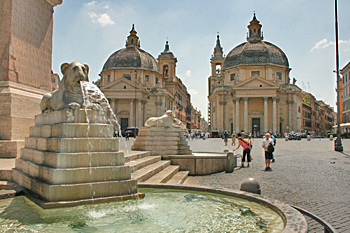
From Piazza del Popolo I wandered further off the tourist track to the Ara Pacis Museum, which is currently displaying ‘45 Years Of Fashion‘ by Italian designer Valentino. The museum, which was designed by the international architect Richard Meier and opened in the spring of 2006, has been subject of much controversy and criticism, as it replaced the Ara Pacis, a more than 2,000 year old “Altar of Peace” that was used (ironically) for sacrifices. While I found the museum to be an abominable white box, I thought the fountain out front was charming.
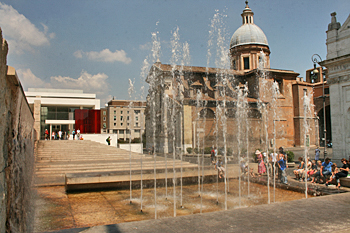
I crossed the Tevere River and wound along the western shore to the Castel Sant’Angelo. Built by the Emperor Hadrian (117-138) as a Mausoleum for himself and his successors, it was completed by Antoninus Pius in 139. As it was one of the few structures not destroyed in the early sacking of Rome, it was converted to a fortress and in 1277 was connected to the Vatican by the famous corridor, a safety passage which runs along the top of the encircling wall of the Vatican. Since then, the Castel has remained under the control of the Popes who have used it as a fortress, as well as a prison and place of torture.
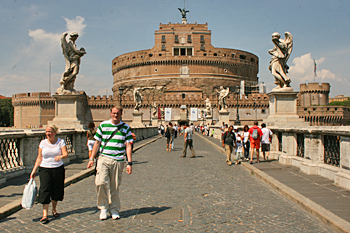
Both the bridge leading to the Castel, as well as the top of the structure are adorned with statues of Archangels as a tribute to a vision of Saint Michael, who appeared, sword in hand, over the mausoleum in apparent answer to the prayers of Pope St. Gregory I the Great (r. 590-604) that a plague in Rome should cease. In honor of the occasion, the pope took to calling the mausoleum the Castel Sant’Angelo (Castle of the Holy Angel), the name by which it is still known.
Crossing back to the other side of the river, I picked my way through side streets to reach Piazza Navona, with Bernini’s dramatic Four Rivers Fountain standing at the center of the piazza in front of the church of Sant’Agnese in Agone.
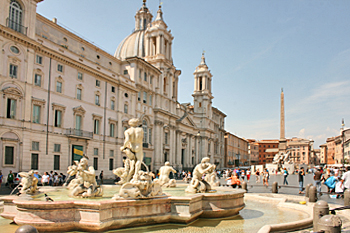
The church was commissioned in 1652 by Pope Innocent X and built on the site where according to legend, St. Agnes was stripped naked, but miraculously saved from disgrace by extraordinary growth of hair. Two other fountains adorn this square: the Neptune Fountain at the northern end of the piazza and the Moor Fountain at the southern end.
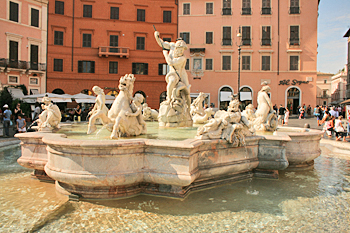

Piazza Navona is one of Rome’s liveliest squares and it was here I put my feet up to enjoy a two hour lunch at an outdoor cafe, watching late afternoon strollers peruse the oil and watercolors of the artists who set up booths all along the square.
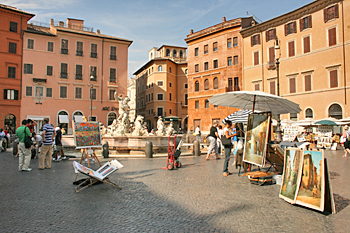
Sufficiently refreshed, I made my second concession of the day to crowds, heading for the Pantheon. Nearly 2,000 years after it was erected by Emperor Marcus Agrippa, the Pantheon is still one of the most impressive buildings in the world.
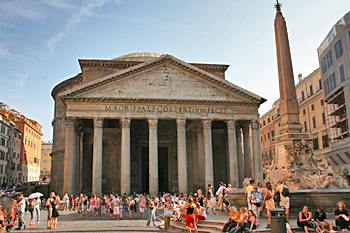
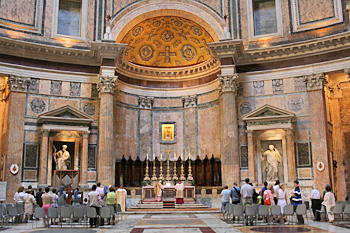
A 141-foot diameter dome with a radius that perfectly matches its height looms over the interior. Originally the Pantheon housed a temple to Rome’s 12 most important deities. Reconsecrated as a church in A.D. 609, it became the burial place of kings. Despite the crowds (check out the photo where I held the camera above my head to capture the press of tourists going in and out of the building), my timing was perfect, as I was just in time to witness a Catholic Mass, complete with all the splendor and ceremony one would expect of a church service in Rome.

After eight hours of walking I finally went back to the hotel, groaning for about the last mile because my feet hurt so bad. But it was worth the pain because walking allowed me to discover the real Eternal City. In the lesser known neighborhoods of Rome I could people watch. At the Pantheon, locals and tourists alike lounged on the steps of the courtyard fountain, indulging in the Roman national pastime – eating Gelato, of course!
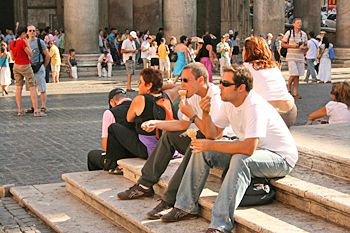
Or the Rome for lovers – I caught these two couples in the act, oblivious to anything else going on around them.
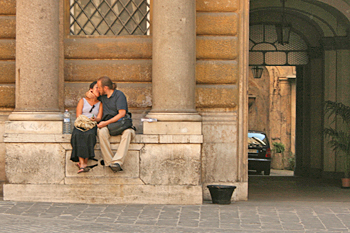
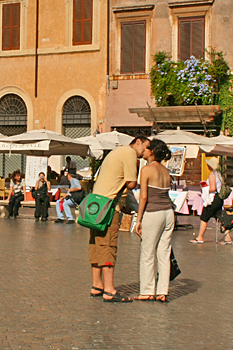
I have saved the best for last – tomorrow is reserved for the Vatican, with its spectacular Saint Peters Basilica and the Sistine Chapel. But I think I will relent and take the subway.

We lived next door to the Vatican and every day would drive around the colonnade lined with statuary. The most incredible thing about Rome is that everywhere you turn, there are statues by all the famous sculptors and painters who had only been names in history books before I lived there. My favorite piazza is a small one — Piazza Barberini which is at the bottom of the Veneto. It just has a special presence or so I always thought. karen